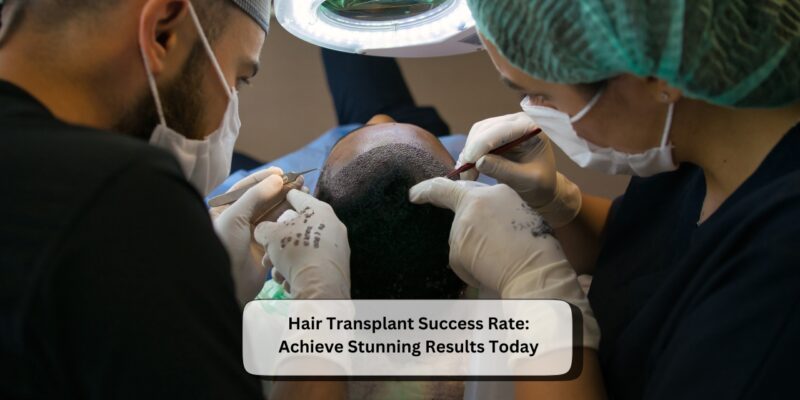Hair Transplant Success Rate: Achieve Stunning Results Today
When it comes to hair transplants, one of the most frequently asked questions is, “What is the success rate?” The idea of restoring lost hair can be both exciting and nerve-wracking. After all, it’s a life-changing decision, and you want the results to be worth the investment. So, what does it really take to achieve a successful hair transplant? In this blog, we’ll dive deep into the factors that influence hair transplant success rate, what you can expect from the process, and how to maximize the outcome.
Hair Transplant Success Rate: Achieve Stunning Results Today
1. What Is Hair Transplantation?
Hair transplant surgery involves relocating hair follicles from one part of the body (typically the back of the head) to areas where hair is thinning or balding. This method works for both men and women facing hair loss due to male pattern baldness, female hair thinning, or other causes of hair loss such as alopecia.
According to Wikipedia, the two primary methods of hair transplant include Follicular Unit Extraction (FUE) and Direct Hair Implantation (DHI). Each technique has its pros and cons, but both aim to achieve natural-looking hair that blends seamlessly with the surrounding hair.
2. Factors Affecting Hair Transplant Success Rate
The success of your hair transplant depends on several factors, each of which plays a significant role in the final outcome. These factors can make the difference between a successful, long-lasting result and a less-than-ideal experience.
a. Surgeon Expertise
One of the biggest influences on the success rate of hair transplants is the surgeon’s skill. A highly trained and experienced hair transplant surgeon is essential for achieving optimal results. A trusted clinic like iGraft ensures that their team of professionals uses the latest techniques and equipment to provide you with the best results.
b. Hair Type and Donor Area Quality
Your hair type, the quality of your donor hair, and the density of your hair in the donor area all play a role in determining how successful your hair transplant will be. People with dense, thick hair often see better results, as the transplanted hair integrates better with the existing hair. If your donor area has weak or sparse hair, your surgeon might have to take extra steps to ensure the hair transplant recovery is successful.
c. Post-Surgery Care
Post-operative care is a crucial part of the hair transplant process. How you take care of your scalp and follow aftercare instructions will impact the success rate of your procedure. Hair transplant recovery involves gentle care, including avoiding strenuous physical activity, protecting the scalp from direct sunlight, and using prescribed medications.
d. Age and Health
Age can affect your transplant success, as younger individuals may have better healing capabilities and denser hair growth, while older individuals might experience slower recovery and more limited hair growth. Additionally, pre-existing health conditions such as diabetes or scalp infections can hinder the success of the transplant.
3. Success Rate of Hair Transplants
Now, let’s talk numbers. Generally, the success rate of hair transplants ranges from 85% to 95%, depending on the factors mentioned above. The best results are often seen within 6-12 months post-surgery, when the transplanted follicles start to grow. Full results can sometimes take up to a year.
Minimizing Risks:
When done right, hair transplant surgeries are usually safe and highly effective. However, there are always risks involved, like infection or poor hair growth, which can lower the success rate of hair transplants. These risks can be minimized with proper post-surgery care and by selecting an experienced surgeon from a reputable clinic such as iGraft.
4. Managing Expectations: When Will You See Results?
Patience is key when it comes to hair transplants. Right after the procedure, your scalp might appear red, swollen, or slightly scabby. You may even lose some of the transplanted hair during the first few weeks, but don’t panic—this is completely normal. This phenomenon is called “shedding,” and it’s part of the hair transplant recovery process.
The transplanted hair follicles will eventually begin to grow new hair in 3-4 months. Most people will notice fuller and thicker hair within 6-12 months. By the 12-month mark, you should have the final results of your hair transplant surgery.
5. How to Maximize the Success of Your Hair Transplant
To ensure you get the best possible results, follow these expert tips:
-
Choose an Experienced Surgeon:
Research and choose a surgeon who specializes in hair restoration. Check their reviews, certifications, and before-and-after photos to ensure they’re trustworthy. Clinics like iGraft are renowned for their skilled team and state-of-the-art techniques. -
Follow Aftercare Instructions:
After your hair transplant, take your surgeon’s aftercare instructions seriously. This might include using prescribed shampoos, avoiding direct sunlight, and taking medications to prevent infection. -
Maintain a Healthy Lifestyle:
Eating a balanced diet, exercising, and staying hydrated all promote healthy hair growth and help your scalp heal better after the transplant. -
Be Patient:
As mentioned earlier, hair transplants take time. It’s essential to stay patient and wait for your hair to grow fully. Keep in mind that individual results may vary.
6. Is Hair Transplant Worth the Investment?
When deciding whether a hair transplant is worth it, you should factor in the long-term benefits of the procedure. Not only does it restore your hair, but it can also significantly improve your confidence and self-esteem. After all, hair loss can be a stressful and emotional experience for many individuals, and the results from a well-done transplant can be life-changing.
The success rate of hair transplants and the positive transformation that comes with it make it a worthwhile investment for many people. The key is to ensure you choose the right surgeon, clinic, and follow the proper aftercare instructions.
Conclusion: Your Journey to Fuller Hair
In conclusion, the hair transplant success rate is high when performed by experienced surgeons like those at iGraft, and with the right aftercare, the results can be long-lasting and natural. Remember, patience is crucial as your hair will gradually grow back, and you’ll start noticing fuller, thicker hair within the first 6 months.
Want to explore your options? Book a consultation at iGraft and begin your journey to restored confidence and fuller hair.
For more information on hair transplant surgery and techniques, check out the Wikipedia page on hair transplantation.










